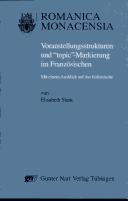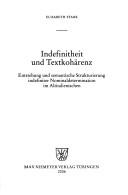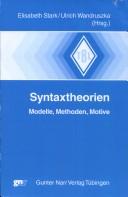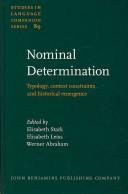| Listing 1 - 8 of 8 |
Sort by
|

ISBN: 3823347918 Year: 1997 Volume: 51 Publisher: Tübingen Gunter Narr
Abstract | Keywords | Export | Availability | Bookmark
 Loading...
Loading...Choose an application
- Reference Manager
- EndNote
- RefWorks (Direct export to RefWorks)

ISBN: 3484523360 9783484523364 3110925834 Year: 2006 Volume: 336 Publisher: Tübingen : Max Niemeyer Verlag,
Abstract | Keywords | Export | Availability | Bookmark
 Loading...
Loading...Choose an application
- Reference Manager
- EndNote
- RefWorks (Direct export to RefWorks)
Die Untersuchung hat die Distribution und funktionale Auslastung von 22 Indefinita in neun Schlüsseltexten der italienischen Sprachgeschichte vom 13. bis zum Anfang des 16. Jahrhunderts (u.a. Dantes »Convivio«, Boccaccios »Decameron«, die »Libri della famiglia« von Alberti, Bembos »Prose della volgar lingua«) zum Gegenstand. Fast 9000 Einzelbelege werden in den nach drei Zeiträumen und Diskurstraditionen kreuz-klassifizierten Texten anhand von mehr als 40 grammatischen und textuellen Kategorien analysiert und bezüglich ihres Zusammenhangs mit Generizität, Prädikativität, Negation, Spezifizität und Zählbarkeit diskutiert. Die Analysekategorien entstammen der aktuellen referenzsemantischen Literatur und werden erstmals in einer empirischen diachronen Studie in ihrer Gesamtheit auf eine große Zahl konkreter Textbelege angewendet. Im Zentrum stehen die Frage nach der semantischen und funktionalen Ausdifferenzierung der Indefinita in den Texten im Vergleich zu ihren lateinischen Etyma und neuitalienischen Entsprechungen sowie insbesondere das Problem der Grammatikalisierung indefiniter Nominaldeterminanten im Italienischen und Romanischen. Die Motivation der Artikelentstehung im Romanischen im indefiniten Bereich wird in der Leistung der unbestimmten romanischen Artikel, einer neuen Art von ›Nominalklassifikation‹ im weiteren Sinne als Kompensation der lateinischen Genus- und Numerusflexion, identifiziert.
Italian language --- Definiteness. --- Italien (Langue) --- Lexicology. Semantics --- Historical linguistics --- Grammar --- Romance languages --- Franco-Venetian language --- Italian language - To 1300. --- Italian language - Definiteness.
Book
ISBN: 9788484895817 8484895815 9783865276278 386527627X Year: 2011 Publisher: Madrid : Iberoamericana,
Abstract | Keywords | Export | Availability | Bookmark
 Loading...
Loading...Choose an application
- Reference Manager
- EndNote
- RefWorks (Direct export to RefWorks)
Spanish language --- Espagnol (Langue) --- Grammar --- Grammaire --- Morphosyntax
Book
ISBN: 9783110376937 9783110377088 9783110393422 3110393425 3110376938 311037708X Year: 2017 Volume: 17 17 17 17 Publisher: Berlin Boston
Abstract | Keywords | Export | Availability | Bookmark
 Loading...
Loading...Choose an application
- Reference Manager
- EndNote
- RefWorks (Direct export to RefWorks)
This volume offers theoretically informed surveys of topics that have figured prominently in morphosyntactic and syntactic research into Romance languages and dialects. We define syntax as being the linguistic component that assembles linguistic units, such as roots or functional morphemes, into grammatical sentences, and morphosyntax as being an umbrella term for all morphological relations between these linguistic units, which either trigger morphological marking (e.g. explicit case morphemes) or are related to ordering issues (e.g. subjects precede finite verbs whenever there is number agreement between them). All 24 chapters adopt a comparative perspective on these two fields of research, highlighting cross-linguistic grammatical similarities and differences within the Romance language family. In addition, many chapters address issues related to variation observable within individual Romance languages, and grammatical change from Latin to Romance.
Romance languages --- Syntax. --- Morphosyntax. --- Grammar --- Neo-Latin languages --- Syntax --- Morphosyntax --- E-books --- Italic languages and dialects --- Romance languages - Syntax --- Romance languages - Morphosyntax

ISBN: 3823357654 Year: 2003 Publisher: Tübingen : Narr,
Abstract | Keywords | Export | Availability | Bookmark
 Loading...
Loading...Choose an application
- Reference Manager
- EndNote
- RefWorks (Direct export to RefWorks)
Book
ISBN: 9783823363682 3823363689 Year: 2008 Publisher: Tübingen : GNV, Gunter Narr Verlag,
Abstract | Keywords | Export | Availability | Bookmark
 Loading...
Loading...Choose an application
- Reference Manager
- EndNote
- RefWorks (Direct export to RefWorks)
Romance languages --- Grammar --- Romanische Sprachen --- Syntax. --- Syntax --- Aufsatzsammlung --- Aufsatzsammlung.

ISBN: 9789027230997 9027230994 9786612152757 1282152750 9027292108 9789027292100 9781282152755 6612152753 Year: 2007 Volume: 89 Publisher: Amsterdam ; Philadelphia : John Benjamins Pub.
Abstract | Keywords | Export | Availability | Bookmark
 Loading...
Loading...Choose an application
- Reference Manager
- EndNote
- RefWorks (Direct export to RefWorks)
The following theoretical-empirical points on the DP are discussed: Article and its referential-anaphoric properties by Abraham (Determiners in Centering Theory); Bartra (On bare NPs in Old Spanish and Catalan); identification of all functional nominal categories by Stvan (Bare singular count nouns); Kupisch & Koops (Specificity and negation); Jäger (History of German indefinite determiners); typological comparison of the interaction of nominal and verbal determination by Abraham (Discourse-functional crystallization of the original demonstrative); Leiss (Covert (in)definiteness and aspect in Old Icelandic, Gothic, Old High German); Lohndal (Double definiteness during Old Norse); emergence of DP in ontogeny/phylogeny by Osawa (DP, TP and aspect in Old English and L1 acquisition); Bittner (Early functions of definites in L1 acquisition); Wood (Demonstratives and possessives emergent from Old English); Bauer ((in)definite articles in Indo-European) and Stark (Variation in nominal indefiniteness in Romance).
Grammar --- Grammar, Comparative and general --- Definiteness (Linguistics) --- Nominals (Grammar) --- Noun-equivalents (Grammar) --- Substantives (Grammar) --- Indefiniteness (Linguistics) --- Linguistics --- Determinatives (Linguistics) --- Determiners (Linguistics) --- Classifiers (Linguistics) --- Determiners. --- Nominals. --- Noun phrase --- Determiners --- Déterminants (Linguistique) --- Définis (Linguistique) --- Nominaux --- Definiteness (Linguistics). --- Languages & Literatures --- Philology & Linguistics --- Nominals --- Philology
Book

ISBN: 9783110361070 3110361078 9783110361872 9783110394740 3110361876 311039474X 9783110361889 3110361884 Year: 2014 Publisher: Berlin Boston
Abstract | Keywords | Export | Availability | Bookmark
 Loading...
Loading...Choose an application
- Reference Manager
- EndNote
- RefWorks (Direct export to RefWorks)
The volume describes the frequency, the forms and the functions of different cleft construction types across two language families: the Romance languages (with discussion of Italian, French and Spanish data) and the Germanic languages (with focus on English, German, Swiss German and Danish).
Syntaxe --- Grammar, Comparative and general --- Romance languages --- Germanic languages --- Frequency (Linguistics). --- Generative grammar. --- Propositions (Linguistique) --- Langues romanes --- Langues germaniques --- Fréquence des mots --- Grammaire générative --- Clauses. --- Grammar, Generative. --- Grammar, Generative --- Syntax. --- Frequency (Linguistics) --- Generative grammar --- Grammar, Transformational --- Grammar, Transformational generative --- Transformational generative grammar --- Transformational grammar --- Psycholinguistics --- Teutonic languages --- Indo-European languages --- Neo-Latin languages --- Italic languages and dialects --- Clauses --- Frequency of occurrence (Linguistics) --- Linguistic analysis (Linguistics) --- Syntax --- Derivation --- Sentences --- E-books --- Syntaxe. --- Linguistics --- Philology --- Cleft Constructions. --- Contrastive Linguistics. --- Germanic Languages. --- Romance Languages.
| Listing 1 - 8 of 8 |
Sort by
|

 Search
Search Feedback
Feedback About UniCat
About UniCat  Help
Help News
News